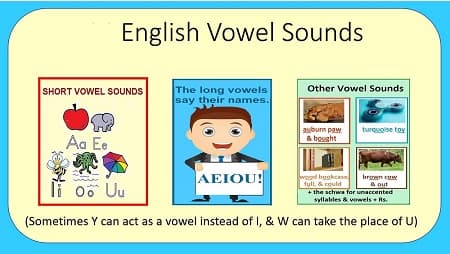Pronounce Vowels in English: A 7-Day Challenge
Are the different spellings of vowels in English driving you crazy? Do they keep you from recognizing words you already know or make you afraid to write anything in English? Do you hesitate to pronounce new English words, not knowing which sounds their vowels will have this time?
Vowels in English can certainly be confusing. A letter can have four or more sounds. Individual vowel sounds can also be written with several different combinations of letters!
Is there any way to make sense of this mess? Will you ever be comfortable reading or writing in English?
You can master the vowels in English by learning a few simple patterns!
Depending on interest, from May 18-May 26, 2023 EnglishHints may be hosting a 7-day challenge: Speak English Clearly by Mastering its Word Stress and Vowels. (I will be talking to some people in early May to decide which to teach first. If there is much more interest in our speaking challenge, that may happen in May instead. See Speaking English Confidently at Work.)
What’s in this Vowels Challenge?

This challenge is a quick way to learn the correct pronunciation of English vowels, so you can speak (and be understood) more clearly. It's designed to help scientists or other professionals who didn't grow up speaking English but use it in their work now.
Its emphasis is on vowel sounds (and word stresses) in common professional vocabulary. Those are the most frequent obstacles keeping many professionals from speaking English as clearly and confidently as they would like to.
English vowels and word stresses are so different from those in many other languages! Listening to these explanations and practicing the vowel sounds and vocabulary can make a real difference in a short time.
Each day includes a short video and 10-20 minutes of review and practice activities for each of the nine "days" or lessons (in addition to repeating the pronunciations in the videos.) So it's about 1/2 hour per lesson. (You'll also record a few sentences for me to review after a few of the lessons. This feedback can help you focus on any areas you may need to work on.)
Day 1 will discuss the importance of word and syllable stresses in English and some rules that can help you.
On days 2-4 you will study and practice
- English short and long vowel sounds (the 10 most common vowel sounds in English),
- the differences between several sounds that can be difficult for many people, especially the difference between seek and sick (or eat and it or bean and bin), and
- an explanation of the (imperfect) rules that can help in figuring out which vowel sound is most likely
Day 5 will practice other common vowel sounds (especially in digraphs like AU, AW, OI, OO, OU or OW, and day 6 will demonstrate the ways vowel sounds can change before Rs (in words like alternative, clarify, neuron, or volunteer).
Day 7 will look at how to apply what you've learned when using professional vocabulary. Notice the difference between motivate and motivation or strategy and strategic.
If you want to speak English as clearly as possible at work, this little challenge can make a big difference for you.
Bonuses
Once you finish the challenge, there are a few optional extra lessons for those who want to keep improving-- or for when you need a little more. (Challenge participants can email me when you have questions about English pronunciation after the challenge is over, as well as during it.)
1. Homophones are words that sound the same but have different meanings. (They usually have different spellings, too.) They’re important to recognize!
If you choose the wrong homophone, a spell checker will usually miss your mistake, since both are English words. Sometimes grammar checkers can catch them. Even native English speakers sometimes miss the difference between their and they're, or affect and effect-- but the wrong word can confuse your reader and looks unprofessional.
2. The Usual Consonant Sounds in English is a quick look at each of the other letters in English, plus common combinations (digraphs) like ch, gh, ng, ph, sh, and th and some times letters are likely to be silent. There are two videos to practice the difference between L and R, if that is difficult for you to hear or pronounce-- because English has so many words that only differ in that one letter. Mispronouncing Ls or Rs frequently leads to communication difficulties and misunderstandings.
3. Past Tense Pronunciation in English, including when to add a syllable and how to pronounce the final 'ed.'
4. A List of 150 Word Families Professionals Should Know, with word stresses marked to make them easier to pronounce.
I believe these bonuses alone are worth nearly the price of the course-- but try them to judge for yourself!.
Take the Vowels in English Challenge This Spring!
Increase your confidence reading, writing, and especially speaking English by mastering English word stress and vowels!
The challenge costs $27 (the lowest I could make it and still review and give feedback on your pronunciation.)
It will probably start Thursday May 18 and run through Friday May 26 (though I will leave it up through Friday June 3 to allow a little extra time to finish it if you have complications in your schedule.)
You'll be able to buy it from around May 10. (I need to set it up on the course platform.) If there is more interest in the speaking challenge, contact me if you would really like this challenge and I can give a discount on a related course.

Your satisfaction guaranteed. Please contact me if you have any problems or questions. If you are not happy with this course, please contact me for a full refund (or a credit plus 10% on a different course if you prefer.)
If you find the course helpful please take a moment to let me know and to share it. Thanks!
Home > ESL Reading > How to Pronounce Vowels in English